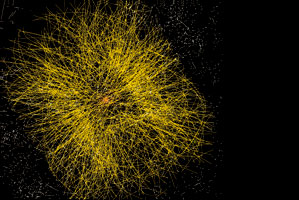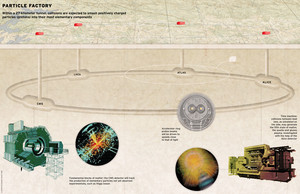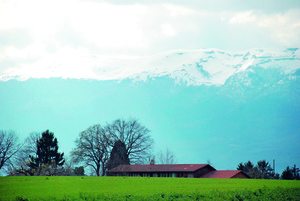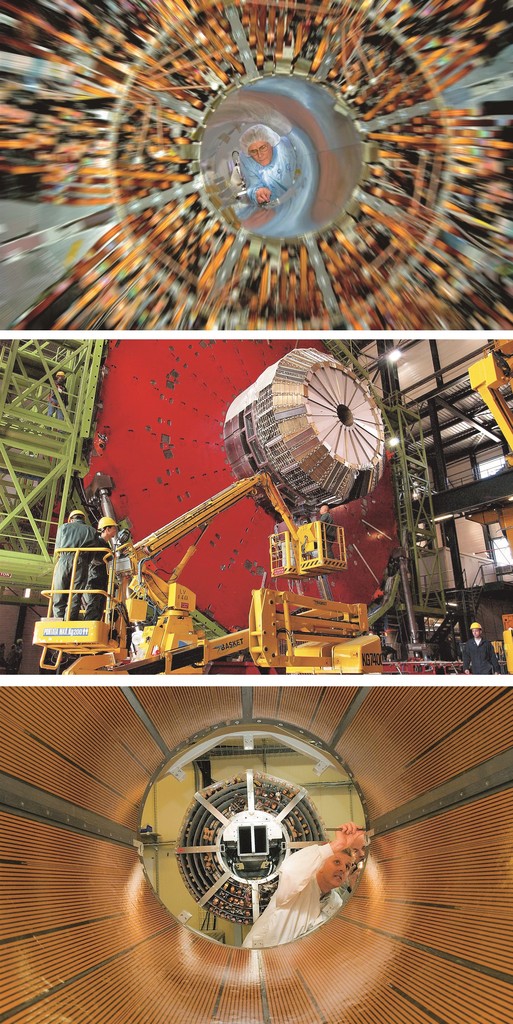
cernFrontal collision: a simulation of lead ion collisions in the Alice detectorcern
* from Geneva
On Sunday, April 6, the town was still sleepy when the streetcar stopped at 8:28 a.m. at Geneva’s central train station, dead on time. In just a few seconds, dozens of people filled its compartments hurriedly, on their way to Cern, the European Organization for Nuclear Research, an international physics laboratory led by twenty European countries and located near the Swiss watch capital. Upon arriving at the huge wooden globe at Cern’s entrance, the small group joined a crowd of people that awaited the opening of the gates, speaking different languages, from a range of countries. Neither the wind nor the 9 degree temperature of the Swiss spring had kept them from leaving the comfort of their heated homes and facing a wait of many hours in long outdoor lines. Nobody wanted to miss the last chance of visiting the cave.
The cave in question, a hundred meters underground, has nothing to do with the Jura mountains that rise to the west of Cern, on the Franco-Swiss border, where two centuries ago the German naturalist Alexander von Humboldt found animal fossils dating back to the geological period that he called Jurassic. The cave everyone wanted to see is one of man’s most impressive creations: a 27-kilometer long circular tunnel that houses the Large Hadron Collider (LHC), the world’s greatest particle accelerator, meant to go on-stream in the next few months. When it is finally switched on in July or August of this year, following almost two decades of planning, construction and delays, this equipment should allow Cern’s 10 thousand physicists and engineers – of whom 68 are Brazilian – to better understand how nature behaves in an infinitely small space, billions of times smaller than a grain of sand.
Before closing the tunnel’s access, the researchers suspended their routine work and the equipment’s fine tuning in early April and turned to another important activity that they engaged in from time to time: showing the world how the almost US$ 9 billion invested since 1993 to date was spent on the manufacturing and assembling of LHC. “They know how to peddle their wares” commented Sandro Fonseca, a Brazilian physicist from the University of the State ofRiode Janeiro (UERJ), during a walk along Cern’s corridors, where he is currently doing his doctorate. “European tax payers come here for an outing to see how their money is being spent.”

RICARDO ZORZETTOHeavyweight: physicists and engineers finish assembling the 12.5 thousand ton CMS detectorRICARDO ZORZETTO
On the first Sunday in April, 53 thousand people, equivalent to one tenth of the population of Geneva and neighboring towns, crossed the gates of the world’s largest particle physics lab in the world. They watched videos, attended lectures on the new accelerator, and heard explanations about the progress that physics has generated in fields such as medicine, with CAT scans, for instance, which enable one to obtain images of working organs, or telecommunications – in 1989, Tim Berners-Lee developed the World Wide Web communication system at Cern, which grew into the Internet to which the public has access.
Those who disregarded their traditional family lunch were also able to visit the Microcosm science museum and even to become acquainted with Cern’s headquarters: the control center, inaugurated in March; from where the monitoring of eight particle accelerators will be conducted. The LHC is the newest and most powerful of them. “There’s nothing to hide here,” said Terry Pritchard, an English engineer who developed and tested electronic components for the LHC for years. He is now retired but served as the journalists’ tour guide.
In the cave
20 thousand of the 53 thousand people who visited Cern descended into the cave. And they were impressed by what they saw. Within thick concrete walls, a succession of 1,624 blue and white tubes,14 meterslong and1 meterwide each, were lined up in sequence, forming a 27-kilometer ring. Within these tubes, two particle beams thinner than a strand of hair will travel in opposite directions at speeds nearing that of light (300 thousand kilometers a second).

RICARDO ZORZETTOUnderground: men, women and children visit the Alice detectorRICARDO ZORZETTO
Guided by powerful electromagnets chilled to-271°C, the particles will keep a parallel path most of the time. At four points in the ring, however, their paths will cross and, like clouds in a storm, beams of 100 billion positively charged particles (protons) will collide with another 100 billion particles coming from the opposite direction. Despite the number of protons, only some 20 collisions are expected when one cloud goes past the other. Therefore, one must cause these clouds to collide millions of times a second in order to generate a sufficiently large number of collisions to make it feasible for physicists to analyze them.
When hurling one proton against another at extremely high speeds and an absurdly high level of energy (7 trillion electron volts or tera electron volts, TeV), the researchers hope to fragment them into their most fundamental components: quarks, matter-forming particles that are smaller and indivisible, and bosons, particles responsible for the transmission of three of the four forces of nature (electromagnetism, the strong nuclear force and the weak nuclear force), which hold the quarks together in bigger blocks of matter.
These particles – a total of 48, of which 36 are of matter and 12 are force carriers – are foreseen in the Standard Model, the set of theories developed over the last 50 years to explain matter’s sub-microscopic behavior. However, some of them havenever been observed experimentally. There is a belief that most – except for the four or five most stable ones – are extremely fleeting and turn into other particles as soon as they are created. With particles escaping through their fingers, physicists are in doubt: either the theory does not represent reality properly and some particles actually do not exist or, up until now, there has been no machine powerful enough to find them.
 “There is a consensus that the Standard Model is sound,” says Arthur Maciel, from the Brazilian Center for Physics Research, in Rio de Janeiro, and a member of one of Cern’s teams. “But it doesn’t explain everything. Perhaps it’s just a good approximation of something more complete that we aren’t aware of yet.” In their quest for an answer, researchers worldwide cannot wait to see the protons start to collide dozens of meters beneath the fields and farmlands onGeneva’s outskirts.
“There is a consensus that the Standard Model is sound,” says Arthur Maciel, from the Brazilian Center for Physics Research, in Rio de Janeiro, and a member of one of Cern’s teams. “But it doesn’t explain everything. Perhaps it’s just a good approximation of something more complete that we aren’t aware of yet.” In their quest for an answer, researchers worldwide cannot wait to see the protons start to collide dozens of meters beneath the fields and farmlands onGeneva’s outskirts.
The general belief is that the LHC is this long-awaited machine. Even if this accelerator produces enough energy to smash protons and solve these issues – the collision of two protons will generate 14 TeV of energy, which is a great deal for a particle, but cannot keep a mobile phone working for more than a few seconds – physicists will face a great deal of work before they can confirm whether or not they have found what they sought.
As fundamental particles are unstable and in just fractions of a second generate other particles, researchers resort to gigantic devices called detectors in order to find out what happened at the site of the collision. Barrel or cylinder shaped, the detectors are built around the point at which the collisions take place. They are comprised of four layers of different materials that record the energy and speed of the particles that go through them, as well as the paths covered.

cern
The start and the mid-point: Felix Bloch lays Cern’s cornerstone in 1955 (top) and John Adams announces an energy record in 1959 (bottom)cernBased on this data, they calculate other properties, such as mass and electrical charge. But they have to follow the reverse path of the second or third generation of particles – from the point when they disappear to when they appear – in order to find out which ones were first generated in the collision. “It’s a kind of reverse engineering,” comments physicist Dílson de Jesus Damião, from the UERJ team of Alberto Santoro, who is working on his doctorate at Cern.
At LHC, there are four main detectors. Two of them, the Atlas (the largest -46 meterslong,25 metershigh and weighing 7 thousand tons) and the CMS – Compact Muon Solenoid (the heaviest -21 meterslong,12 metershigh and weighing 12.5 thousand tons) will analyze the proton collisions in a quest for Standard Model particles not yet found and hitherto unknown physics phenomena. As for Alice (an acronym for A Large Ion Collider Experiment), it will only run for three months a year in order to analyze the outcome of the collisions of heavier particles (the nuclei of the chemical element lead) and check on the presence of a fifth matter state: the quarks and gluons plasma.
Comprised of two kinds of elementary particles – the quarks, matter particles, and the gluons, force-carrying particles – this plasma supposedly only exists at extremely high temperatures, such as those produced in the first instants after the Big Bang, the explosion that may have given origin to space and time itself, 13.7 billion years ago. Once created, this primordial soup of particles may have existed for a minute fraction of a second, when the Universe was very hot and small: its temperature was as high as one quadrillion degrees (today it is-270 °C) and it covered a mere 300 million kilometers, virtually nothing compared to its current 117 sextillion kilometers.

CERN
On the border: between Switzerland and France, above the dotted lineCERNAn old acquaintance
A more modestly dimensioned detector, the LHCb, will specifically investigate the disintegration of elementary particles of matter called mesons B in other particles. The objective is to try to understand why the amount of matter in the Universe differs from the amount of anti-matter, which consists of particles with the same mass but opposite charges and rotating in the opposite direction. “The figures measured through two other experiments, Babar and Belle, did not explain the difference found in the Universe,” explains electronic engineer Rafael Nóbrega, who is doing his PhD at the National Institute of Nuclear Physics in Rome and who spent the last few months testing the 15 thousand chips and 1,400 cameras of an LHCb detection system that records events lasting only billionths of seconds.
As the inauguration of the new Cern accelerator approaches, one particle in particular has become popular with newspapers and magazines worldwide: the Higgs boson. Perhaps this frisson is justified, although all this noise has bothered the physics community, especially after Leon Lederman, the American who won the 1988 Nobel Prize for Physics, called it the God particle in his book The God particle: if the Universe is the answer, what is the question?, published in 2006.
Suggested in 1964 by a Scotsman, physicist Peter Higgs, this interaction particle, if found, will explain the mass of all the other elementary particles, and why some of them have mass whereas others do not. “The theoreticians have fun discussing what would be worse: discovering Higgs boson with the properties foreseen in the Standard Model, or discovering there is no Higgs boson,” wrote John Ellis, an English physicist from Cern, in an article published in July 2007 ina Nature special on the LHC.
The first case would stand for yet another achievement of this theory, which has passed all the tests to which it has been submitted to date, but would add nothing new to physics. If this particle does not exist, however, the Standard Model is doomed and physicists will be obliged to explain the results to the politicians that lent their support to financing the LHC. “Whichever path nature takes, the good news is that LHC will provide us with a definitive experimental answer and will put an end to speculation,” stated Ellis.

ricardo zorzetto
In the hills: fields merge with Cern facilitiesricardo zorzetto“Physics will become more interesting if Higgs boson isn’t found, because we’ll have to rethink everything that has been done up to now,” commented Roberto Salmeron, a Brazilian physicist who lives in Paris and talks from the experience of one who has witnessed the birth of most of modern physics. The last Brazilian assistant to Gleb Wataghin, the Italian who trained the first generation of physicists inBrazil, Salmeron joined Cern in 1956, two years after it was founded. “Nobel Prize winner Patrick Blackett, who was my advisor at theUniversityofManchester, suggested that Cern invite physicists who studied cosmic rays to think about the experiments that should be carried out, once the first accelerator was ready,” he said. “In Cern’s early days, we worked in wooden huts on loan from the Geneva airport.”
In lieu of huts, it is now established around the city in hundreds buildings of only a few stories, which give no indication that under the surface researchers are investigating the most intimate phenomena of matter. Having the LHC go on-stream is the realization of a dream at least three decades old. Even before the previous accelerator went into operation, European researchers were already thinking about replacing it with bigger, more powerful equipment, which is why they insisted on building such a long tunnel.
The idea gained strength in the mid 1980s, when Cern’s long-term planning group, headed by Carlo Rubbia, the Italian who shared the 1984 Physics Nobel Prize for discovering the particles that carried the weak nuclear force (bosons W and Z), suggested that this would be a healthy way for European particle physics to remain competitive vis-à-vis the United States’ efforts in this field. At the time, the United States were planning to build, on their own account, the Superconducting Super Collider (SSC), a more expensive accelerator that was about six times more powerful than the LHC. However, the project was shelved in 1993 after Congress cut its budget. The Americans then tried to revive the international cooperation agreements that they had turned down previously, but were unsuccessful in this endeavor: it was too late. Rubbia’s persuasiveness and his lectures in several European countries led American experts to recommend to their government joining the new Cern accelerator project, which also enjoyed support from Russia, Japanand India, according to Chris Llewellyn Smith, Cern director from 1994 to 1998, inthe Nature special.

cern
Particle path: experts fine tune equipment in the Atlas and the CMS, the largest detectors (center)cernThis was not the first time that a multinational collaboration prevailed over countries’ individual initiatives. Indeed, combining efforts lies at Cern’s very roots. When World War II ended in 1945, Europe was in a shambles in economic and social terms and some of its main researchers had migrated to theUnited States. “At a 1949 conference inLausanne, Switzerland, Frenchman and Physics Nobel Prize winner Louis de Broglie proposed the creation of laboratories shared by European countries in order to rebuild scientific activity in that continent,” tells us Salmeron.
Another two physicists, Pierre Auger, a Frenchman, and Edoardo Amaldi, an Italian, liked the idea and worked hard to create a particle physics laboratory. “Amaldi, who had a rare global vision of science and of its impact upon society, suggested Cern’s behavior philosophy, which has been followed since its inception: a laboratory open to all countries, with no secret activity nor military influence,” said Salmeron, whose work over the last few years has been fundamental for Brazilian involvement with the LHC.
Instability
Thanks to his prestige in Brazil and abroad, Salmeron coordinated, years ago, the negotiations between the Ministry of Science and Technology (MST), Finep, the Studies and Projects Financing Agency, and CNPq, the National Council for Scientific and Technological Development, which led to a budget of US$ 1 million (about R$ 2 million) a year for five years – the last installment is to be disbursed in July of this year. “What was granted was only R$ 1.8 million, enough to pay for the tickets, hotel and annuities, but not to produce equipment,” commented Salmeron, who could not get over the fact thatBrazil lost toPakistanthe opportunity to manufacture one of Cern’s electromagnets. According to him, the only reason why Brazilian participation has not been jeopardized is the good will of groups of friends abroad that finance the Brazilians. He is not the only person to complain about the government’s lack of consistent and ongoing support for particle physics. The coordinators of Cern’s Brazilian teams stated that the lack of long-term national planning gives rise to damaging instability in this field. “Everything works on the basis of individual requests for financing,” says Jun Takahashi, from the State University of Campinas (Unicamp), who works at theAlicedetector. “In an experiment of this magnitude, there’s no room for uncertainty.” Fernando Marroquim de Almeida, from the Federal University of Rio de Janeiro (UFRJ), comments: “I have been working with the Atlas detector for almost 20 years, yet every year I have to go to CNPq to ask for money and explain what I do. So it seems the government wants no long-term commitment. Cern’s leadership has been requesting that Brazil subscribe a memorandum of understanding, which has already been signed by smaller and poorer countries, such as Morocco, Chile, AzerbaijanandPoland.”
“We have had a collaboration agreement for years, and it must be renewed, eventually (the last cooperation agreement was signed in 2006),” states José Roberto Drugowich de Felício, CNPq’s head of horizontal programs. The agency has two lines of grants: one concerning maintenance and operation rates and another to cover expenses to construct equipment. “From 1999 to 2004, CNPq disbursed R$ 1.2 million to build a piece of equipment for the Atlas detector,” he tells us. “Besides, we’ve supported research groups with grants for PhDs to study abroad for two years, rather than for the normal one-year period.”
The lack of national planning may also jeopardize the impact of Brazilian work on this project, states physicist Renata Funchal, from the University of São Paulo (USP), who years ago was a member of a French team that worked at Cern’s old accelerator. “The Brazilian community is small and it was scattered over the four LHC experiments, whereas in the large programs, the United States and the European countries embrace an aggressive and targeted policy, focusing on taking part in specific experiments,” comments Renata.
Still, the country is playing an effective role within the Cern project. At UFRJ, Marroquim’s team developed chips that were produced and tested by two companies from the state ofSão Pauloand that are installed in the Atlas detector.
Additionally, in Rio de Janeiro and São Paulo, the groups linked to Alberto Santoro, from UERJ, Alejandro Szanto Toledo and Marcelo Munhoz, from USP, and Sergio Novaes, from Paulista State University (Unesp), implemented in the country a computing complex that is equivalent to one thousand networked computers, connected to each other and to Cern by ultra-fast Internet links. “Thus, the money invested and the knowledge generated remains inBraziland we make an effective contribution to the analysis of Cern data,” states Novaes.
It is not just previously unknown physics and particles that may surface aroundGeneva. “There is a major gain, and one that it’s hard to measure, which is the educational one, that can only be achieved through this type of collaboration,” states Takahashi. “My students work in cooperation with a thousand people productively; they learn programming in advanced languages and then they join domestic companies.”
The LHC in figures
The particle beams are kept at-271°C
The particles will be accelerated along a 27-kilometer long ring
Protons will reach the speed of 1.079 billion kilometers per hour or 99.9999991% of the speed of light
Every second, the particles will go round the accelerator’s ring 11,245 times
600 million collisions are expected to take place per second
The collision energy will reach 14 trillion electron volts, which is very high for particles, but barely enough to run a mobile phone for a few seconds
The collisions are expected to generate 70 thousand gigabytes of data per second
Approximately 10 thousand physicists and engineers will take part in LHC’s experiments
Cern’s 2007 budget amounted to almost US$ 1 billion